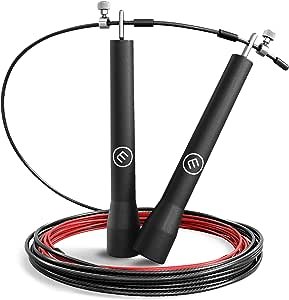Are you looking to elevate your cardio routine with a jump rope but feeling lost in the sea of options available? With so many choices on the market, it can be challenging to determine which type of jump rope is right for you. Two popular options that often spark debates among fitness enthusiasts are nylon jump ropes and speed ropes. In this comprehensive guide, we’ll break down the differences between nylon jump ropes and speed ropes to help you make an informed decision and take your workouts to the next level.
Nylon Jump Ropes: Versatility Meets Durability

Nylon jump ropes, also known as traditional jump ropes, have been a staple in fitness routines for decades. These ropes are typically made from nylon, PVC, or a similar durable material and feature handles with bearings for smooth rotation. Here are some key characteristics of nylon jump ropes:
- Versatility: Nylon jump ropes are versatile and suitable for various fitness levels and workout styles. Whether you’re a beginner looking to master basic jump rope techniques or an advanced athlete aiming to incorporate complex moves into your routine, a nylon jump rope can accommodate your needs.
- Durability: Nylon jump ropes are known for their durability, making them an excellent long-term investment for your fitness arsenal. The sturdy construction ensures that the rope can withstand frequent use and intense workouts without wearing out quickly.
- Weight: Nylon jump ropes come in different weights, allowing you to customize your workout intensity. Lighter ropes are ideal for speed and agility training, while heavier ropes provide more resistance for a challenging full-body workout.
- Control: The thicker construction of nylon jump ropes provides better control and feedback, allowing you to maintain a consistent rhythm and technique during your jumps.
Speed Ropes: Unleash Your Agility and Speed

Speed ropes are designed specifically for one thing: speed. These ropes feature lightweight materials such as thin cables or PVC-coated wire and minimalist handles for maximum agility. Here’s what sets speed ropes apart:
- Speed: As the name suggests, speed ropes are built for fast-paced workouts, making them perfect for high-intensity interval training (HIIT) and improving agility and coordination. The lightweight design allows you to perform rapid jumps with minimal effort, helping you maximize calorie burn and cardiovascular benefits.
- Minimalist Design: Speed ropes often have sleek, minimalist handles that prioritize agility and comfort. The reduced handle size minimizes hand fatigue during extended workouts and allows for quick wrist movements, essential for maintaining a rapid pace.
- Portability: Due to their lightweight and compact design, speed ropes are highly portable and convenient for on-the-go workouts. Whether you’re traveling, hitting the gym, or exercising outdoors, a speed rope easily fits into your gym bag or suitcase, ensuring you never miss a workout session.
- Advanced Techniques: Speed ropes are favored by athletes and advanced jumpers for mastering intricate jump rope techniques such as double-unders, crossovers, and alternating footwork. The lightweight construction and fast rotation speed enable you to execute these moves with precision and finesse.
Which Jump Rope Is Right for You?
Choosing between a nylon jump rope and a speed rope ultimately depends on your fitness goals, preferences, and skill level. Here are some factors to consider when making your decision:
- Fitness Goals: If you prioritize versatility and durability for a variety of workout styles, a nylon jump rope may be the best option. However, if you’re focused on maximizing speed, agility, and advanced jump rope techniques, a speed rope is likely the better choice.
- Skill Level: Beginners may find nylon jump ropes more forgiving and easier to control, allowing them to focus on mastering basic jump rope techniques before advancing to more complex moves with a speed rope. Advanced athletes and experienced jumpers may prefer the speed and agility offered by speed ropes to challenge themselves and push their limits.
- Comfort and Preference: Consider factors such as handle design, grip comfort, and rope weight when choosing between nylon jump ropes and speed ropes. Ultimately, selecting a jump rope that feels comfortable and suits your personal preferences will enhance your overall workout experience and motivation.
In conclusion, both nylon jump ropes and speed ropes offer unique benefits and cater to different fitness goals and skill levels. Whether you’re aiming to improve cardiovascular health, boost agility, or master advanced jump rope techniques, incorporating either type of rope into your workout routine can lead to significant fitness gains. Experiment with both options to discover which jump rope aligns best with your needs and preferences, and get ready to jump your way to a healthier, fitter you!
